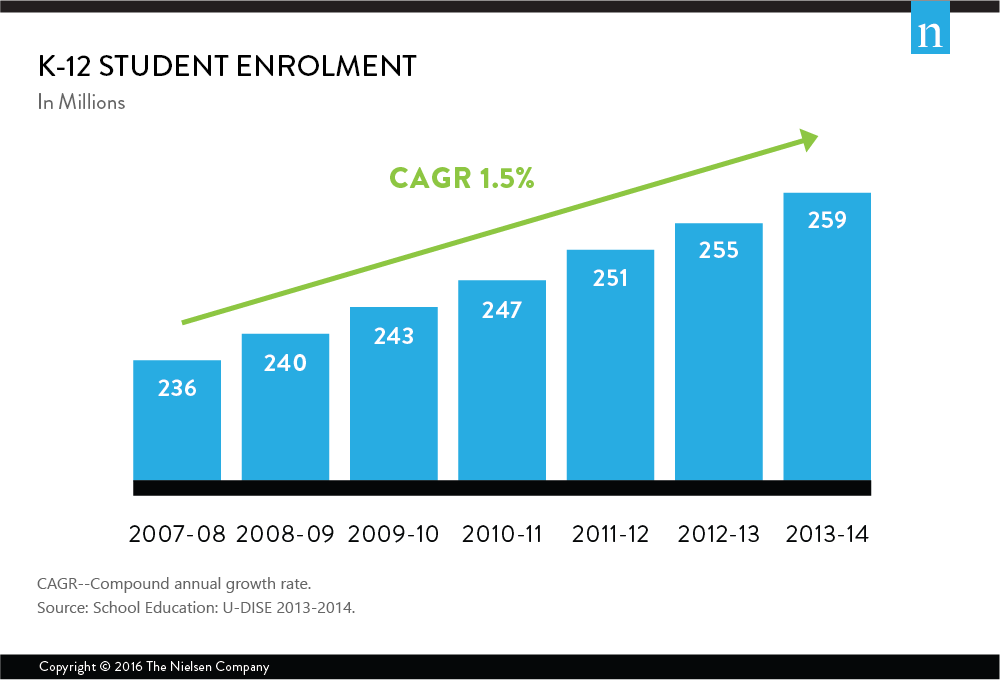인도의 문해율은 지난 10년 동안 정부의 교육 투자 덕분에 크게 향상되었습니다. 2009년 전국 청소년 독서율 조사에 따르면, 인도 청소년 4명 중 3명이 글을 읽을 수 있으며, 청소년 인구의 1/4(무려 8,300만 명)이 스스로를 책 읽는 사람이라고 밝혔습니다. 2020년까지 이 나라의 문해력 수준은 90%에 달할 것으로 예상됩니다.
이는 전 세계 도서 산업에 큰 영향을 미칩니다.
인도는 현재 12억 8천만 명이 넘는 인구를 보유한 세계에서 두 번째로 인구가 많은 나라입니다. 인구 증가 예측에 따르면 2030년 말에는 인도의 인구가 약 15억 3,000만 명으로 현재 가장 인구가 많은 국가인 중국을 넘어설 것으로 예상됩니다.
이러한 놀라운 인구학적 성장과 더불어 인도 경제는 지난 3년 동안 연평균 8.6%의 GDP 증가율을 기록하며 견고한 성장세를 이어가고 있습니다. 이로써 인도는 세계에서 가장 빠르게 성장하는 경제 대국이 되었습니다.
닐슨북은 인도의 출판을 산업 차원에서 더 잘 이해하기 위해 대규모 연구 프로젝트를 수행하여 인도 도서 시장 보고서를 발간했습니다. 이 연구에서는 출판 산업의 경제적 변수와 도서 시장 규모를 검토하는 것 외에도 정부 프레임워크와 정책, 개정된 법률이 도서 출판, 도서 구매 행동 및 다양한 유형의 출판에 대한 도서 소비자의 특성에 미치는 영향에 대해서도 살펴보았습니다.
그렇다면 인도 시장을 구성하는 도서의 종류에는 어떤 것들이 있을까요?
즐거움을 위한 독서가 시장의 중요한 구성 요소이고 일반 상업 도서(소설, 논픽션, 비교육용 아동 도서)의 독자층도 늘어날 것으로 보이지만, 국내 전체 도서 시장의 대부분은 교과서가 차지하고 있습니다. 실제로 초중고 교과서 구매는 전체 도서 시장의 약 71%를 차지하고 있으며, 고등 교육용 도서가 22%를 추가로 차지하고 있는 것으로 추정됩니다.

인도의 전체 인구는 점점 더 교육을 받고 있습니다. 2013-2014년 초중고 교육 총 등록률(GER)은 84.6%였으며, 기획위원회는 이 수치가 2017년까지 93.2%로 상승할 것으로 예상했습니다. 이는 초등학교에서는 거의 100%, 중등 학교에서는 90% 이상, 고등 학교에서는 65% 이상의 등록률을 의미합니다. 교육 도서 부문의 시장 성장에 대한 닐슨의 예측에 따르면 이미 매우 중요한 이 시장은 향후 5년 동안 약 19% 성장할 것으로 예상되며, 이는 더 많은 수의 어린이가 학교에 입학하고 더 오래 머물며 학습에 필요한 자원을 지원할 수 있는 부모가 늘어날 것으로 예측됩니다.

인도 인구 통계의 독특한 특징, 특히 글을 읽고 교육받은 젊은 층의 인구 증가는 교육뿐만 아니라 모든 분야에서 출판 산업의 성장과 확장을 위한 엄청난 기회를 제공합니다. 하지만 이러한 엄청난 기회에는 도전과제가 따르기도 합니다. 예를 들어 인도에는 22개의 공식 언어가 있으며, 모든 주의 지역 언어와 방언을 포함하면 그 수는 1,600개 이상으로 늘어납니다.
인도의 오프라인 서점들은 인구통계학적으로 세분화된 시장에 대처해야 할 뿐만 아니라 이커머스가 제공하는 새로운 채널과의 시장 경쟁에도 대응해야 합니다. 이러한 온라인 소매업체는 다른 국가와 마찬가지로 점점 더 많은 모바일 인구를 대상으로 제품 범위와 가격 면에서 매력적인 경우가 많습니다. 다른 장애물로는 국가의 지리적 위치와 규모, 열악한 인프라로 인한 비효율성과 비용 등이 있습니다. 이로 인해 출판사는 대량의 책을 전국 각지에 배포하는 것이 물류상의 문제가 됩니다.
그러나 인도 도서 시장이 직면한 많은 어려움에도 불구하고 이 산업은 빠르게 성장하고 있으며, 일자리를 창출하고 인도의 교육과 문해력 향상에 기여하고 있습니다. 이 활기차고 영향력 있는 중요한 분야에서 일하는 사람들은 이제 도서 산업이 재정적 지원을 받고 정부와 더욱 긴밀히 협력하여 국가의 전반적인 발전을 도모할 수 있도록 '산업' 지위를 부여받아야 할 때라고 믿습니다.



